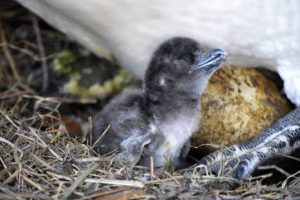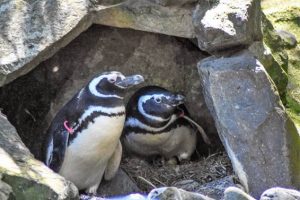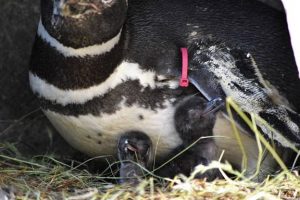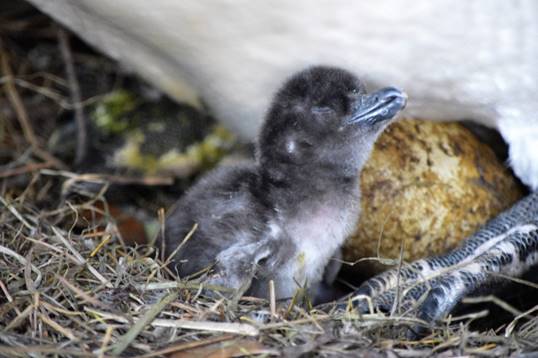Submitted by Point Defiance Zoo and Aquarium
A Magellanic penguin chick hatched at Point Defiance Zoo & Aquarium on Tuesday. It was the first hatching of a penguin at the zoo since 2006.
The zoo has four mating pairs of penguins, and all have been sitting on eggs.
It’s possible another chick could pip (or break) its way through an egg in the coming days or weeks. (Note: Another chick was born on Friday).
Zookeepers believe there is at least one more fertile egg among the group. Parents incubate the eggs in shifts; they hatch between 38 and 42 days after they’re laid.

“We are delighted with the hatching of this chick,” said staff biologist Amanda Shaffer, who is the zoo’s lead penguin keeper. “The pairings of these adults came as the result of a breeding recommendation through the Species Survival Plan® (SSP) for Magellanic penguins.”
The chick’s parents are keeping close watch on their offspring and feeding it, Shaffer said. The father spent much of Tuesday afternoon huddled in their burrow, “brooding” on the chick. Parents keep their eggs and young warm by covering them with what’s called a “brood patch,” or separation of feathers on the lower part of their abdomens. This allows direct contact with their skin.
The protectiveness of the parents means it could be some time before zoo visitors are able to see the chick, which is hidden most of the time. It does make appearances for feeding, which is accomplished when the parents regurgitate bits of the herring and capelin they’ve already eaten; it’s a protein-filled slurry for the hungry little mouth.
Zookeepers have not had an opportunity to closely examine the hatchling and weigh it. Its parents weigh between nine and 10 pounds each.
Point Defiance Zoo & Aquarium’s penguins are not named, but rather are known by the colors of the bands on their wings. The newly hatched chick’s mother is “Pink” and its father is “Red.”
Magellanic penguins are listed as near-threatened on the IUCN Red List. The International Union for Conservation of Nature catalogs species around the world on its Red List to graphically show the toll environmental factors and human encroachment are taking on animal populations.
The medium-sized penguins are native to the shores of South America, ranging around the southern end and tip of the continent along the coasts of Chile, Argentina, Uruguay and Brazil. They average about 27 ½ inches tall and can live up to 25 years in the wild.

The chick’s parents and the SSP® embody several facets of Point Defiance Zoo & Aquarium’s global conservation mission. “Pink” and “Red” were among four penguins the zoo took in from a Brazilian rehabilitation facility six years ago.
Rescuers believed they went in search of food, got caught up in currents and didn’t have the energy to return to their homes, Shaffer said. They remained at the rehabilitation facility for about a year before finding homes in Tacoma.
Penguin Point’s other adult penguins were all hatched in zoos; three right here in Tacoma and one at Blank Park Zoo in Iowa.
Rescuers believed they went in search of food, got caught up in currents and didn’t have the energy to return to their homes, Shaffer said. They remained at the rehabilitation facility for about a year before finding homes in Tacoma.
Penguin Point’s other adult penguins were all hatched in zoos; three right here in Tacoma and one at Blank Park Zoo in Iowa.
Point Defiance Zoo & Aquarium Conservation Engagement team members talk to visitors about ways they can help penguins in the wild. Among the threats Magellanic penguins face are oil spills and other forms of pollution, climate change, and the depletion of their food sources by overfishing.

Plastic pollution in the world’s ocean also poses a major threat to penguins and other sea birds. The animals easily can become entangled in plastic rings that hold six packs of canned drinks together, lost or discarded fishing nets, ropes and other objects. Sea birds also can ingest particles of plastic objects that have broken into smaller pieces in the ocean currents. And some birds, mistaking the colorful bits of plastic as food, pick it up and feed it to their young.
Point Defiance Zoo & Aquarium is taking part in a worldwide effort to educate members of the public about plastic pollution in the ocean and present zoo visitors with ideas on simple actions they can take to help eliminate the trash that finds its way to the sea through rivers and stormwater runoff. Those actions include ditching single-use water bottles in favor of a reusable bottles, taking reusable bags on shopping trips, and refusing plastic bags at grocery stores, department stores and other retail outlets.
Ten larger-than-life sculptures of sea creatures made entirely of ocean trash currently dominate the landscape in the zoo’s main lawn area. They illustrate the growing threat of plastic in the seas to marine animals. The Washed Ashore: Art to Save the Sea exhibit www.pdza.org/washed-ashore enlightens visitors and inspires them to take action. It will be at the zoo through Oct. 21.
In addition, Point Defiance Zoo & Aquarium, in partnership with food concession vendor Lancer Hospitality, eliminated the sale of single-use plastic water, soda and juice bottles earlier this year. In cooperation with Wildlife Trading Co., which operates the gift shop, single-use plastic shopping bags also are no longer offered on zoo grounds.
The zoo is encouraging visitors and the general public to go Plastic-Free to Save Our Sea!
Point Defiance Zoo & Aquarium is open from 9:30 to 6 p.m. daily.
For more information about the zoo, visit the zoo’s website.













































